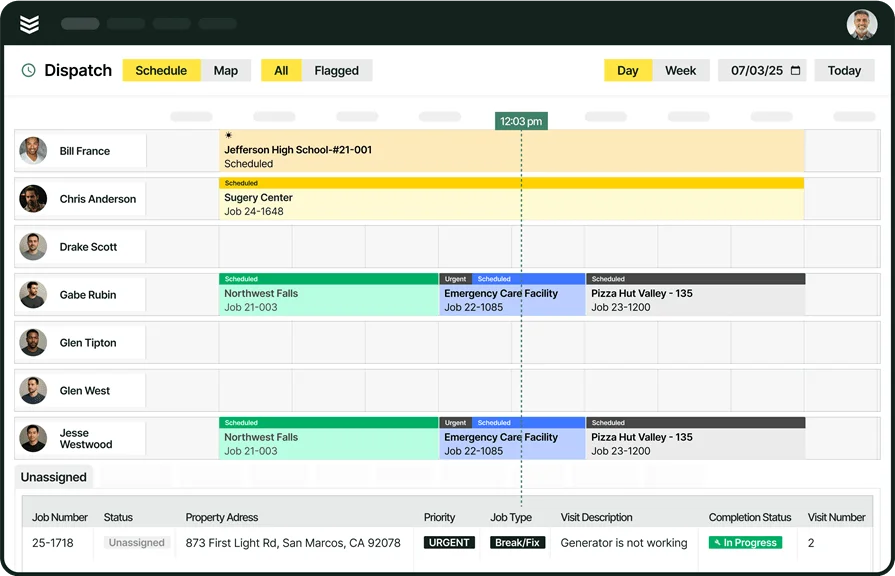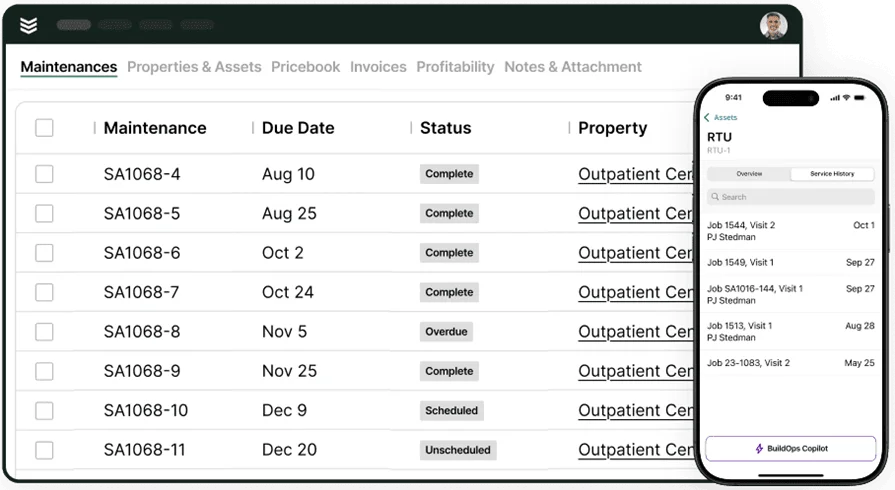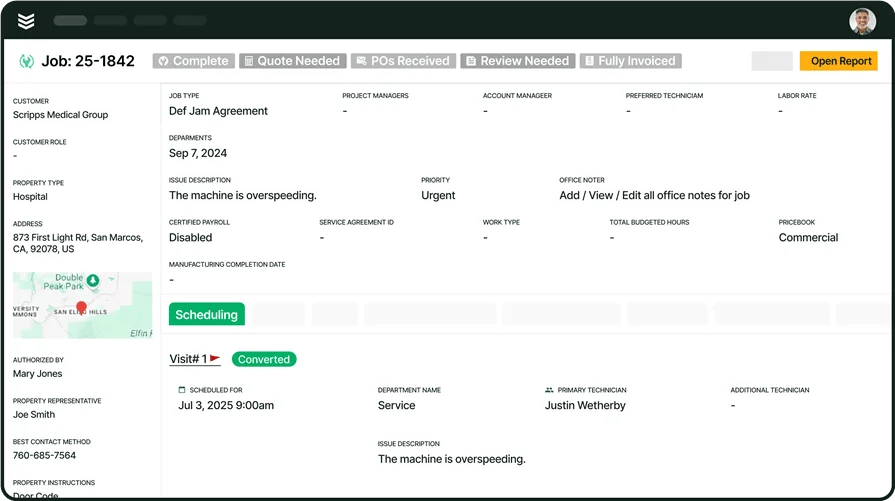Keeping track of technicians, job timelines, and changing priorities gets messy fast—especially in the fast-moving world of HVAC. Miss one detail, and your whole day can unravel. That’s where HVAC planning software comes in. Instead of juggling calendars, spreadsheets, and back-and-forth texts, planning tools built for HVAC teams bring everything into one place—helping you assign jobs, track progress, and keep your schedule tight.
In the HVAC industry, where every job is tied to equipment uptime and customer expectations, getting the planning side right is critical. Whether it’s coordinating teams across job sites or handling last-minute emergency calls, field planning software helps contractors stay organized, efficient, and ready for anything. Here’s what we’ll cover to help you find the best HVAC planning solution for your crew:
- Choosing the best HVAC planning software for your team
- 6 key features to look for in HVAC planning tools
- Best for commercial contractors: BuildOps
- Best for residential: Housecall Pro
- Best for general contractors: Tradify
- Other valuable HVAC planning software providers
- 7 benefits of using HVAC planning software
- 4 important HVAC planning FAQs answered
Plenty of planning tools exist, but not all are cut out for HVAC work. Here’s how to spot one that actually fits the way your team runs jobs.
Choosing the best HVAC planning software for your team
Planning goes deeper than assigning time slots—it connects every moving part of your HVAC business. From office coordinators juggling dispatch boards to techs checking schedules on their phones, your team needs one system that works for both sides. That’s where HVAC planning software proves its value—keeping the entire crew aligned and reducing the chaos that slows jobs down.
Here’s what to consider before making your pick:
- Office and field coordination - Does the software help your office crew stay in sync with techs in the field? Can job updates, reroutes, and delays be shared instantly? Are field teams getting the info they need without having to call in?
- Ease of use - Can your team learn it quickly and put it to work the same day? Will techs use it in the field without needing constant help? Do your office staff prefer it over spreadsheets or manual logs?
- Cost vs. value - Are you getting features that actually support how your team works? Does it reduce reschedules, missed appointments, or admin headaches? Are you investing in something the whole crew will use daily?
- Integration with existing tools - Does it connect with your current systems—like scheduling, CRMs, or payroll? Can job and customer data move easily between platforms? Will it help eliminate double entry and extra admin work?
- Features - Can you assign jobs in real time? Does it send updates, task lists, and routes to a tech’s phone? Can it balance workloads, track daily progress, and keep everything visible from one screen?
Once you know what to look for, the next step is digging into the features that actually support your workflow. Not all HVAC planning software comes with tools that matter in the field. Here’s what to prioritize.
6 key features to look for in HVAC planning tools
When techs are stacked with service calls and the office is fielding last-minute schedule changes, staying ahead takes more than a whiteboard and a phone chain. HVAC planning software brings structure to the chaos—allowing you to assign jobs, balance workloads, and adjust on the fly without losing sight of the bigger picture. These tools don’t just keep jobs moving; they keep your crew connected.
When multiple emergency HVAC repairs occur simultaneously, dispatchers need immediate visibility of technician availability, required parts, and proximity to the site. Field planning software streamlines this process, enabling quick technician rerouting, job updates, and client alerts with just a few clicks, replacing time-consuming calls and estimations. Key features facilitate this efficiency.
1. Real-time dispatch and schedule visibility
A live dispatch board is the backbone of any dependable HVAC planning software. Your team needs to see job status, open slots, tech availability, and task changes instantly. With field service dispatch software, dispatchers can match the right tech to the right job, adjust routes mid-day, and react fast when emergencies come in.
For example, if a service call wraps up faster than expected, your dispatcher can instantly reassign that tech to a nearby no-cool complaint without picking up the phone. The tech sees the update immediately on their device and heads straight to the next job.
2. Access to service history and job notes
Service calls move faster when techs walk in prepared. With CRM tools built for HVAC, your team can access customer records, system details, and past job notes directly from the platform—no digging through files or calling back to the office.
Consider a returning customer with chronic issues tied to a packaged rooftop unit. Your tech sees detailed records from the last two visits and heads in knowing exactly what to test and what parts to bring—cutting diagnostic time in half.
3. Built-in time tracking
Keeping tabs on where your hours go is a major part of smart planning. With time tracking software, your office can monitor labor hours per job, track clock-ins from the field, and spot bottlenecks that slow down your crew.
Say your team is falling behind on late-day appointments. Reviewing tracked hours from the past week shows two techs consistently get stuck at the same commercial site. The data helps you rebalance workloads and reassign tasks so no one’s stuck playing catch-up at 5 p.m.
4. Fleet and technician management
If you don’t know where your people are, you can’t plan your next move. Fleet management software gives dispatch a real-time map view of vehicle locations, helping them route techs efficiently and provide accurate ETAs to customers.
Let’s say two techs are caught in traffic after a job runs long. A third tech finishes early and pops up nearby on the map. Instead of delaying a service call, the office dispatches that available tech with the click of a button—keeping your schedule intact.
5. Mobile access for technicians
Any planning tool is only as strong as its ability to reach the field. With technician mobile app tools, crews can access job details, asset history, photos, and notes directly from their phones—whether they’re in the truck or on-site.
Imagine a tech stepping into their first job of the day with no printed work order. Instead, they pull up everything they need—equipment details, customer notes, and prior recommendations—right from the app, making the job faster and smoother.
6. Invoicing and payment capabilities
Jobs should end with payment, not paperwork. Invoicing software and payment tools let techs handle billing on-site, reducing follow-up work and speeding up cash flow.
Picture a routine coil cleaning job finished on-site. The tech generates the invoice, takes payment through a mobile reader, and confirms the job closed—all before heading to the next call. No delays, no manual entry, no missing payments.

Explore our HVAC platform
See how we help HVAC contractors organize operations and boost profitability.
Other valuable features of HVAC field planning software that are worth considering
While some features are essential for staying on top of daily scheduling and dispatch, others serve as enhancements—helping HVAC contractors fine-tune operations, improve reporting, and build long-term customer relationships. These add-ons aren’t make-or-break, but they can push a solid HVAC planning software to the next level.
- Pipeline tracking - Keeping track of upcoming jobs, estimates, and follow-up tasks gets easier with pipeline tracking tools. These features help you manage sales opportunities, unscheduled bids, and project stages—all in one place—so you never lose sight of potential work.
- Service agreement management - With service agreement software, HVAC businesses can plan recurring maintenance, automate renewal tracking, and lock in long-term client relationships. This adds predictability to your workload and builds a consistent service schedule your team can count on.
- Custom reports and operational insights - Planning effectively starts with visibility. With reporting software, contractors can pull reports on job durations, technician utilization, and task completion rates. These insights help spot bottlenecks, justify hiring decisions, or show clients the full value of your work.
Now that we’ve covered the features that matter most, let’s look at the HVAC planning software platforms that stand out—starting with the top choice for commercial contractors.
Best for commercial contractors: BuildOps
BuildOps is purpose-built for commercial HVAC contractors who need to manage high-volume service schedules across large teams and multiple job sites. As a full HVAC field planning software solution, it centralizes scheduling, dispatching, and job coordination into one platform—giving both office staff and field techs a shared view of the day’s work.
With everything updated in real time, the platform helps eliminate miscommunication, cut delays, and keep jobs moving without the usual back-and-forth.
How pricing works: BuildOps offers customized pricing based on your shop’s size, number of users, and specific workflows. That way, you’re only paying for what helps your operation run smoother—no add-ons you’ll never touch.
Key features that support HVAC planning:
- Real-time job board with technician assignments
- Centralized schedule updates and service order visibility
- Automated dispatch workflows for emergency and routine calls
- Workload balancing tools for teams handling overlapping job types
- Custom dashboards for forecasting and team management
What sets it apart for commercial shops: Planning depends on timing, and BuildOps gives your team the tools to own every minute of the day. Dispatchers can reassign jobs on the fly. Technicians see real-time updates without needing a call. Managers track the full schedule without chasing status reports. That means faster decision-making, better crew utilization, and more jobs completed on time.

Take a closer look at BuildOps
We give your team control over jobs, timelines, and technician availability.
Best for residential contractors: Housecall Pro
Image Source: Housecall Pro
Housecall Pro is built with residential HVAC service in mind. Its interface is simple, mobile-friendly, and geared toward fast-moving operations—perfect for teams that handle repeat maintenance calls, same-day jobs, and need to stay in constant contact with homeowners. From scheduling appointments to sending reminders and processing payments, everything happens in one place. However, HVAC companies with more complex planning needs or multiple job types may outgrow its functionality as their team scales.
How pricing works: Housecall Pro uses a tiered monthly subscription model, with plans based on features and user count. Entry-level plans are more affordable but may lack the robust automation or customization that larger teams require.
Key features that support residential HVAC teams:
- Online booking and appointment scheduling
- Automated reminders and follow-ups for customers
- Real-time updates to techs via mobile app
- Drag-and-drop dispatch calendar
- Simple invoicing and payment collection from the field
What sets it apart for residential shops: For smaller HVAC companies or single-truck operations, Housecall Pro removes planning friction. It handles the full lifecycle of a service call—scheduling, dispatch, customer updates, and payment—without needing multiple tools or a steep learning curve. It’s ideal for fast, responsive workflows where the customer experience is front and center.
Best for general contractors: Tradify
Image Source: Tradify
Tradify was designed for contractors managing multiple trades, including HVAC, plumbing, refrigeration, and electrical. It works especially well for small-to-mid-sized businesses that do project-based work across various job types. Its HVAC planning software functions cover everything from job creation to technician allocation, and it brings quoting, scheduling, and communication under one roof. That said, for HVAC-only contractors needing deep dispatch automation or commercial-level tracking, Tradify may feel too generalized.
How pricing works: Tradify offers a flat-rate monthly subscription per user with access to all core features. There are no complicated tiered plans, which makes it appealing for teams that want all the tools without navigating pricing add-ons.
Key features that support general contractor workflows:
- Centralized job cards combining quoting, scheduling, and task tracking
- Technician calendars with drag-and-drop rescheduling
- Time tracking tools integrated into daily schedules
- Mobile app access for field crews to view and update job status
- Simple invoicing and quote conversion features
What sets it apart for general contractors: Tradify keeps everything tied to the job. Whether you’re handling a new install, service visit, or mixed-scope project, it links scheduling to the bigger picture—quotes, materials, technician time, and status updates. For contractors who wear multiple hats, this makes planning smoother across different job types and crews.
Other valuable HVAC planning software providers
Beyond the top picks for specific contractor types, there are several other HVAC planning software platforms worth considering. These tools offer a variety of features—from scheduling and dispatch to mobile apps and job tracking—and may be a strong fit depending on your business size, field planning needs, and growth stage. Each one brings something to the table, even if they aren’t fully built for commercial-scale HVAC workflows.
Workiz
Image Source: Workiz
Workiz is a solid option for small-to-medium HVAC service businesses that need a quick and easy way to manage appointments, dispatch techs, and communicate with customers. It offers an intuitive calendar, automated text reminders, and even a call tracking system—all of which are helpful for keeping planning organized across a lean team. With a strong focus on day-to-day scheduling and lead management, it fits well for companies growing out of paper or spreadsheet-based systems. However, it may lack the depth of customization and reporting larger HVAC companies need for detailed field planning.
How pricing works: Workiz uses tiered monthly pricing based on users and feature access. Higher tiers unlock more automation, reporting, and integrations.
Key features that support HVAC planning:
- Visual job calendar with drag-and-drop rescheduling
- Real-time technician tracking
- In-app communications and customer alerts
- Lead management tools tied to scheduling
- Service history and invoice tracking
What sets it apart: Workiz makes it easy to keep tabs on leads, schedule jobs quickly, and automate key communications—making it a great tool for high-volume residential teams that want to move fast without a lot of setup time.
FieldPulse
Image Source: FieldPulse
FieldPulse combines dispatching, scheduling, quoting, and invoicing in one mobile-first platform. It’s especially well suited for HVAC contractors running smaller operations who need strong field planning software that works from a phone or tablet. The platform includes technician job status updates, routing, and schedule visibility—all useful for managing tight service windows. That said, its capabilities may fall short for multi-crew businesses that require more complex resource allocation or large-scale job coordination.
How pricing works: FieldPulse pricing starts with a base monthly cost and adds per-user fees depending on team size. All plans include access to the full feature set.
Key features that support HVAC planning:
- Daily and weekly scheduling boards
- On-the-go quote and invoice creation
- GPS-based technician tracking
- Task assignment and checklists
- Customer notifications and reminders
What sets it apart: The FieldPulse mobile experience is built for contractors in the truck. For HVAC pros who manage everything from their phone, it offers the flexibility to plan, dispatch, and close jobs without relying on office staff.
ServiceTitan
Image Source: ServiceTitan
ServiceTitan is a well-known platform among enterprise and mid-sized HVAC businesses. It offers a robust suite of tools—dispatching, scheduling, estimating, customer management, and analytics—all built to support growth and efficiency. It’s ideal for planning across high-volume job pipelines and multi-crew service teams. However, the platform’s complexity and pricing structure may not be ideal for smaller HVAC shops looking for a lightweight or simpler solution.
How pricing works: ServiceTitan operates on a quote-based pricing model tailored to company size and desired features. Expect enterprise-level pricing that matches its broad functionality.
Key features that support HVAC planning:
- Real-time schedule updates and GPS-tracked tech locations
- Advanced dispatch board with custom filters
- Capacity planning and job forecasting
- Integrated CRM with full service history
- Workflow automation and job tracking
What sets it apart: ServiceTitan shines when it comes to analytics and scaling. It helps HVAC leaders plan not only for the next day but the next quarter—making it a strategic tool for contractors who want to fine-tune every part of their field operations.
ServiceTrade
Image Source: ServiceTrade
ServiceTrade focuses heavily on commercial service contractors and stands out for companies that perform recurring maintenance, inspections, and planned service agreements. Its scheduling features are closely tied to long-term service plans, asset tracking, and job status updates—making it especially useful for managing large commercial portfolios. However, the tool’s planning capabilities lean more toward contract-based workflows, which may not be a perfect fit for residential or fast-paced repair services.
How pricing works: ServiceTrade offers tiered subscription plans based on team size and business model, with advanced tools available in higher tiers.
Key features that support HVAC planning:
- Recurring service scheduling for long-term contracts
- Asset-level job tracking and documentation
- Technician dispatch with real-time job updates
- Integration with accounting and billing platforms
- Service history and photo documentation tools
What sets it apart: ServiceTrade’s strength is in long-term visibility. For contractors managing maintenance-heavy portfolios or compliance-driven work, it simplifies the planning behind every visit.
Service Fusion
Image Source: Service Fusion
Service Fusion is designed for growing field service businesses, offering all-in-one functionality for scheduling, dispatch, estimates, and invoicing. It balances ease of use with essential planning features like GPS tracking, technician status updates, and calendar management. For HVAC contractors scaling operations and looking for a tool that doesn’t overcomplicate planning, it’s a solid option. Still, teams that need advanced field coordination or customizable workflows may eventually run into limitations.
How pricing works: Service Fusion provides flat-rate monthly pricing with unlimited users, which makes it attractive for teams that want predictable costs.
Key features that support HVAC planning:
- Job scheduling and dispatch in real time
- Tech tracking and mobile work orders
- Customer notifications via text or email
- Quick estimates and invoice generation
- Centralized dashboard for managing jobs
What sets it apart: Service Fusion offers an easy entry point for HVAC businesses ready to ditch manual tools. It’s especially useful for companies that want one platform to manage daily planning without a steep learning curve.

Get the HVAC Growth Report
See how leading HVAC professionals are growing—and scaling—their business.
7 benefits of using HVAC planning software
Solid planning is the backbone of any high-functioning HVAC team. When your crew knows where they’re going, what they’re walking into, and how their day is structured, the rest of the job runs smoother. HVAC planning software is about creating a system that removes guesswork, keeps your field and office aligned, and gives you more control over time, people, and performance. Here’s what you can expect when you make planning a priority.
1. Faster job turnaround times
The more efficient your schedule, the more jobs you can complete in a day—without piling on stress or sacrificing quality. HVAC planning software helps optimize routes, reduce idle time, and respond to changes in real time. When your field and office teams are in sync, even emergency calls can fit smoothly into the day. That kind of responsiveness becomes a true asset when paired with strong HVAC scheduling and dispatching processes, which enable real-time reassignments and route changes without the chaos.
2. Better customer communication
Customers don’t just want good work—they want clarity on when you're arriving and what to expect. Planning tools allow dispatchers to send updates automatically, confirm job times, and notify customers of delays with minimal friction. This benefit multiplies when your team is supported by trained HVAC dispatchers who manage updates in the field and act as a direct line between the crew and the customer.
3. More accurate job quoting
Planning the day properly gives techs the breathing room to do a full assessment, suggest fixes, and build realistic quotes. HVAC planning software makes sure your team isn’t racing the clock—so quotes reflect the actual time, labor, and materials needed. Using HVAC quoting software that connects directly to your planning tools ensures those estimates stay consistent from field to office.
4. Smoother handoffs between teams
When everyone is working off the same schedule and job info, there’s less miscommunication and fewer gaps. HVAC planning software ensures field techs, office admins, and billing teams can all access the same job data and status updates in real time. This becomes especially important when invoicing is involved—mastering HVAC invoicing helps connect the dots from scheduled work to final billing without needing separate tools or extra follow-up.
5. Fewer missed opportunities and callbacks
Good planning prevents rushed jobs, and rushed jobs are where most callbacks start. When techs have enough time to complete a job and document findings clearly, issues get resolved the first time. HVAC planning software also helps track recommendations for future service, so nothing falls through the cracks. This ties directly into how your team handles upsells and follow-ups—HVAC bidding workflows become more effective when planned into the schedule instead of treated as an afterthought.
6. Easier workforce management
Planning software gives you visibility into tech availability, job distribution, and daily workload—all critical for keeping your team balanced. You can adjust on the fly if someone runs long or a call comes in late, without leaving others overloaded. Instead of guessing where the gaps are, you can plan smarter from the start—helping reduce burnout, boost productivity, and get better use of every tech’s time.
7. Clearer operational forecasting
Planning software doesn’t just help today—it gives you the data to plan next week, next month, and next season. Over time, patterns in job types, timelines, and team performance start to emerge, giving you a better read on what’s coming. That level of forecasting helps HVAC businesses staff more confidently, manage workload peaks, and make informed decisions without relying on gut feel.
4 important HVAC planning FAQs answered
Whether you’re switching from manual methods or upgrading from a basic tool, choosing HVAC planning software comes with questions. Below are a few of the most common ones contractors ask when deciding how to manage their schedule, dispatch, and team planning more effectively.
1. What is HVAC planning software?
HVAC planning software helps contractors schedule jobs, assign techs, track workloads, and manage job timelines—so both field and office teams stay aligned and on schedule. It also helps reduce costly errors by centralizing updates, ensuring everyone sees the same information in real time.
Beyond the basics, good planning software gives visibility into technician availability, supports last-minute changes, and helps reduce idle time and callbacks. It connects the moving parts of your day into one system your entire team can rely on.
2. Who needs HVAC planning software?
Planning software isn’t only for large crews—it brings structure to any HVAC business that wants better control over time, tasks, and resources. If any of the following sound familiar, your team will benefit from having a system that keeps jobs, techs, and timelines organized:
- You’re handling dispatch and reschedules by phone, text, or paper
- Technicians are often unclear about where to go or what tools to bring
- The office spends hours each week trying to fill in scheduling gaps
- Customers are calling to ask about late arrivals or missed appointments
- You’re losing track of job progress, field updates, or follow-ups
- Your current system can’t support multiple teams, job types, or recurring service
- Planning daily routes, workloads, or capacity is more guesswork than process
3. How much does HVAC planning software cost?
Pricing depends on your team size, the features you need, and whether the tool is built for residential, commercial, or general contracting work. Some providers charge flat monthly rates, others offer per-user pricing. Basic platforms can start under $100/month, while all-in-one systems designed for commercial operations may require custom quotes based on workflows, integrations, and support level.
Keep in mind—cost isn’t just about price. The right software should help reduce job delays, increase completed calls per day, and eliminate hours of admin, making it a worthwhile investment even for lean teams.
4. What are best practices when using HVAC planning software?
Planning tools are only as effective as how your team uses them. These best practices help you get the most from your software—whether you’re dispatching five techs or managing multiple service teams across job types.
- Keep your schedule live – Update dispatch boards in real time to reflect job changes, delays, or new assignments
- Use skill-based assignments – Match techs to jobs based on tools, certifications, or job history
- Leverage mobile access – Make sure your field crew uses the mobile app for updates, notes, and tracking
- Track performance data – Review hours per job, repeat visits, and travel time to adjust your daily strategy
- Integrate quoting and invoicing – Tie planning into the full service lifecycle to streamline job flow from start to finish
- Review technician feedback – Use crew input to spot issues in the schedule and improve the process
- Audit recurring services – Use the software to plan out maintenance work and reduce emergency gaps
- Set planning priorities daily – Start each morning by reviewing top-priority calls, tech availability, and any carryover jobs to lock in a clear, realistic schedule
In HVAC, planning is about how you get through the day without losing time, money, or patience. A job gets delayed, a tech gets rerouted, a customer reschedules at the last minute—your ability to adapt in real time depends on how strong your planning system is. That’s why choosing HVAC planning software is about more than features; it’s about finding a tool that actually fits how your team works in the field.
Whether you’re managing five techs or fifty, the goal’s the same: fewer headaches, faster jobs, and a team that knows what’s next without asking. If you’re running commercial work with complex scheduling needs, an all-in-one platform like BuildOps can bring everything under one roof—from dispatch to invoicing—so the day stays under control no matter how it changes.

Curious how BuildOps works?
We help HVAC teams simplify day-to-day operations and remove guesswork.








